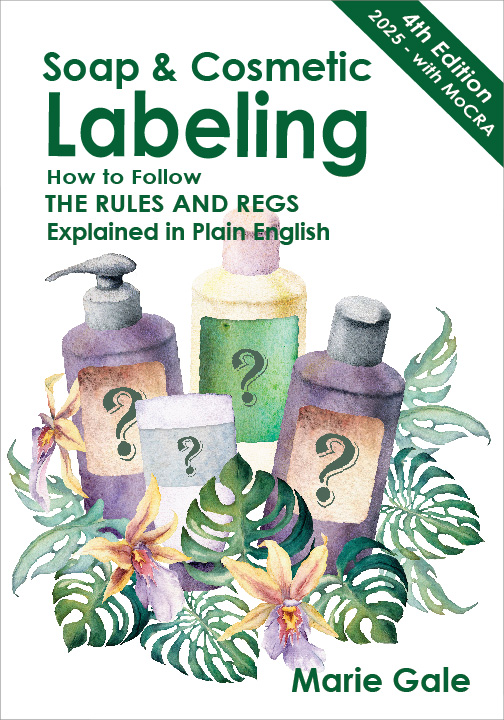When looking at the minutiae of labeling a soap or cosmetic product, it’s easy to forget the big picture. Why are all these regulations in place? Why is it important to comply with them?
Why Are There Regulations At All?
In the USA, regulations are the rules that are put in place to implement the laws that are passed by Congress.
When an Act is passed by Congress it becomes law for the country. These laws are often pretty general as written, and there can be a lot of opinions about what a person or business must to do comply with them. It can be touchy, especially when dealing with a polarizing issue. So usually part of the law gives authority to the appropriate agency to create regulations to implement the law.
The responsible agency has to figure out the specifics: How big is “big enough?” What is a “reasonable price?” How often is “as needed?” Once they have some ideas, they must go through a lengthy process of getting public comments and input from stakeholders, come up with a final draft (for more comments), and then finalize and publish the regulations.
Where Do Soap & Cosmetic Labeling Regulations Come From?
Most of the soap and cosmetic labeling regulations—in fact, labeling regulations for most all products—come from the Fair Packaging and Labeling Act (FPLA). It was passed by Congress in 1966 and had minor updates in 1992. It’s pretty short (only 10 pages long with comments) and fairly general in its statements. The first section, the Congressional declaration of policy, states:
Directly from the Act:
Informed consumers are essential to the fair and efficient functioning of a free market economy. Packages and their labels should enable consumers to obtain accurate information as to the quantity of the contents and should facilitate value comparisons. Therefore, it is hereby declared to be the policy of the Congress to assist consumers and manufacturers in reaching these goals in the marketing of consumer goods.
FPLA
The FPLA goes on with some details on exactly what accurate information on the quantity of contents should be provided. The section in the FPLA on the net contents1 simply says:
Directly from the regulations:
Shall contain letters or numerals in a type size which shall be (i) established in relationship to the area of the principal display panel of the package, and (ii) uniform for all packages of substantially the same size;
1453(a)(3)(C)
The FPLA gives authority to the FDA to create regulations for food, drugs and cosmetics. It was up to the FDA to determine how to calculate the size of the principal display panel, and decide what size of type should be required, What they finally came up with is much more detailed and precise:
Directly from the regulations:
(i) The declaration shall be in letters and numerals in a type size established in relationship to the area of the principal display panel of the package and shall be uniform for all packages of substantially the same size by complying with the following type specifications:
(1) Not less than one-sixteenth inch in height on packages the principal display panel of which has an area of 5 square inches or less.
(2) Not less than one-eighth inch in height on packages the principal display panel of which has an area of more than 5 but not more than 25 square inches.
(3) Not less than three-sixteenths inch in height on packages the principal display panel of which has an area of more than 25 but not more than 100 square inches.
(4) Not less than one-fourth inch in height on packages the principal display panel of which has an area of more than 100 square inches, except not less than one-half inch in height if the area is more than 400 square inches.
Where the declaration is blown, embossed, or molded on a glass or plastic surface rather than by printing, typing, or coloring, the lettering sizes specified in paragraphs (i)(1) through (4) of this section shall be increased by one-sixteenth of an inch.
Other sections of the regulations include how to calculate the size of the principal display panel, and how to measure the height of the letters.
Regulations Eliminate Uncertainty
We’ve all been taught not to “break the law.” For most people, the idea of breaking the law brings some sort of mental or spiritual discomfort. When a person is unsure of what the law is, how it will be interpreted, or how to comply, it can cause a consistent uncertainty and stress that can become burdensome and uncomfortable over time. Regulations can eliminate uncertainty about whether you are following the law as expected, or not.
Following the Regulations Brings Peace of Mind
In the case of the net contents on your soap or cosmetic label, the regulations state how tall the text needs to be in order to be “large enough in relation to the principal display panel” and “sufficient to help the consumer make a value comparison.” All you need to do is get out a ruler and measure.
If you measure your text, and if it is large enough, you have the peace of mind that comes from knowing that your label complies with the regulations and therefore you are not breaking the law in that instance.
The Big Picture
So, believe it or not, in the big picture, the regulations are there to ASSIST you! They exist to give you specific, measurable guidelines to determine if you are complying with the law or not. In most cases, you don’t have to guess, you just need to measure (or otherwise check).

Shameless plug!
To really be able to create your own labels that comply with the regulations, get my book from Amazon and use it.
4th Edition – Released March 5, 2025!!!
Or order directly from me (and get a signed copy)!
- 1453(a)(3)(C) ↩︎


Leave a Reply